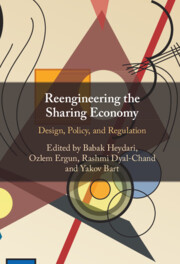Refine search
Actions for selected content:
48285 results in Computer Science
7 - Contemplating the Next Generation of Sharing Economy Regulation
- from Part I - Cross-Cutting Foundations and Norms for the Sharing Economy of Tomorrow
-
-
- Book:
- Reengineering the Sharing Economy
- Published online:
- 30 March 2023
- Print publication:
- 06 April 2023, pp 95-114
-
- Chapter
-
- You have access
- Open access
- HTML
- Export citation
13 - Future Themes in the Sharing Economy
- from Part II-B - Applications of Tomorrow
-
-
- Book:
- Reengineering the Sharing Economy
- Published online:
- 30 March 2023
- Print publication:
- 06 April 2023, pp 228-246
-
- Chapter
-
- You have access
- Open access
- HTML
- Export citation
Part I - Cross-Cutting Foundations and Norms for the Sharing Economy of Tomorrow
-
- Book:
- Reengineering the Sharing Economy
- Published online:
- 30 March 2023
- Print publication:
- 06 April 2023, pp 11-114
-
- Chapter
-
- You have access
- Open access
- HTML
- Export citation
How fast do we forget our past social interactions? Understanding memory retention with parametric decays in relational event models
-
- Journal:
- Network Science / Volume 11 / Issue 2 / June 2023
- Published online by Cambridge University Press:
- 04 April 2023, pp. 267-294
-
- Article
-
- You have access
- Open access
- HTML
- Export citation
Classical (co)recursion: Mechanics
-
- Journal:
- Journal of Functional Programming / Volume 33 / 2023
- Published online by Cambridge University Press:
- 04 April 2023, e4
-
- Article
-
- You have access
- Open access
- HTML
- Export citation
Stochastic comparisons of largest claim and aggregate claim amounts
- Part of
-
- Journal:
- Probability in the Engineering and Informational Sciences / Volume 38 / Issue 2 / April 2024
- Published online by Cambridge University Press:
- 04 April 2023, pp. 245-267
-
- Article
-
- You have access
- Open access
- HTML
- Export citation
Preface
-
- Journal:
- Probability in the Engineering and Informational Sciences / Volume 37 / Issue 2 / April 2023
- Published online by Cambridge University Press:
- 03 April 2023, pp. 322-323
-
- Article
- Export citation
OSO volume 28 issue 1 Cover and Front matter
-
- Journal:
- Organised Sound / Volume 28 / Issue 1 / April 2023
- Published online by Cambridge University Press:
- 19 May 2023, pp. f1-f2
- Print publication:
- April 2023
-
- Article
-
- You have access
- Export citation
OSO volume 28 issue 1 Cover and Back matter
-
- Journal:
- Organised Sound / Volume 28 / Issue 1 / April 2023
- Published online by Cambridge University Press:
- 19 May 2023, pp. b1-b2
- Print publication:
- April 2023
-
- Article
-
- You have access
- Export citation
Reducing ageism focusing on stereotype embodiment theory: Pre-registered study and Bayesian analysis approach
-
- Journal:
- Experimental Results / Volume 4 / 2023
- Published online by Cambridge University Press:
- 31 March 2023, e17
-
- Article
-
- You have access
- Open access
- HTML
- Export citation
On generalization of the sense retrofitting model
-
- Journal:
- Natural Language Engineering / Volume 29 / Issue 4 / July 2023
- Published online by Cambridge University Press:
- 31 March 2023, pp. 1097-1125
-
- Article
- Export citation
Think about the stakeholders first! Toward an algorithmic transparency playbook for regulatory compliance
-
- Journal:
- Data & Policy / Volume 5 / 2023
- Published online by Cambridge University Press:
- 31 March 2023, e12
-
- Article
-
- You have access
- Open access
- HTML
- Export citation

Reengineering the Sharing Economy
- Design, Policy, and Regulation
-
- Published online:
- 30 March 2023
- Print publication:
- 06 April 2023
-
- Book
-
- You have access
- Open access
- Export citation
Behavioural equivalences for continuous-time Markov processes
-
- Journal:
- Mathematical Structures in Computer Science / Volume 33 / Issue 4-5 / April 2023
- Published online by Cambridge University Press:
- 30 March 2023, pp. 222-258
-
- Article
-
- You have access
- Open access
- HTML
- Export citation
What do data portals do? Tracing the politics of online devices for making data public
-
- Journal:
- Data & Policy / Volume 5 / 2023
- Published online by Cambridge University Press:
- 30 March 2023, e10
-
- Article
-
- You have access
- Open access
- HTML
- Export citation
Towards the conceptual design of ML-enhanced products: the UX value framework and the CoMLUX design process
-
- Article
-
- You have access
- Open access
- HTML
- Export citation
The problem of varying annotations to identify abusive language in social media content
-
- Journal:
- Natural Language Engineering / Volume 29 / Issue 6 / November 2023
- Published online by Cambridge University Press:
- 29 March 2023, pp. 1561-1585
-
- Article
-
- You have access
- Open access
- HTML
- Export citation
